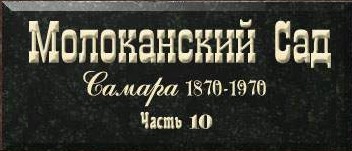
|
Molokan
Orchard
by Prof.
George Vladimir.
Bichurov
and Associates,
Samara State Technical University
|
24 июня 2006 года в
разделе "Молоканский
сад" размещена план-схема.
|
Schematic maps were
placed in the "Molokan
Orchard" section on June, 24, 2006.
|

|
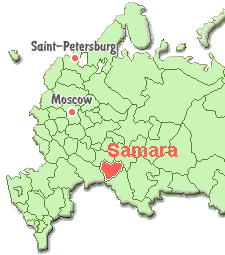
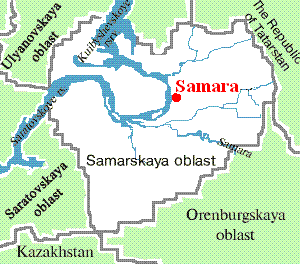
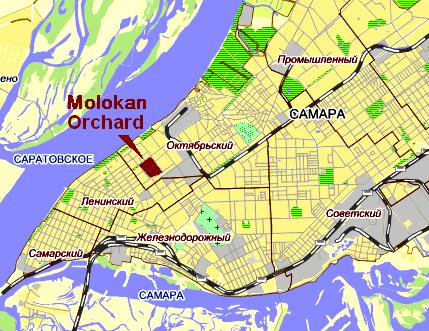
Click on maps to
ENLARGE
|
| The Molokan Fruit Orchard is recorded
as early as 1852 on a Samara City planning maps at the north edge of
the
city. The Molokan Orchard region continued for more than 100 years, up
to the
1960s. The city grew and this fruit farm became a suburb — log
homes, then
apartments and parks. A few original trees still remain in the parks
but the old name was changed during Soviet times. |
See maps of Samara
showing the Molokan Orchard at the north-end of town for: 1852, 1887a, 1887b, 1898, 1909, 1911, 1914a, 1914b, 1915a, 1915b, 1916a, 1916b
See many more photos in Album 1: Molokan Orchard in
Samara, 1870-1970, 1870-2000, After
2000. Some photos are
displayed here with links to their source.
|
МОЛОКАНЕ
— одна из сект духовных христиан. Возникла в России во второй
половине 18 века. Отвергают священников и церкви, совершают моления в
обычных домах. Общинами руководят выборные старцы-пресвитеры.
Постепенно разделились на ряд групп.
|
MOLOKANS
— One of the sects of Spiritual Christians. They arose in
Russia in the after 1750. They reject priests and churches,
and performed prayer in ordinary houses. They appointed elder lay
ministers, presbyters. Gradually they divided into a number of groups. |
Молоканский сад ... Этот
фруктовый сад был посажен в конце 20-х годов XIX века купцом Грачевым
Акинфием Прохоровичем, молоканом по вероисповеданию. По плану 1853 года
землемера Федорова рядом с этим садом предполагалось создание жилой солдатской
слободы. В 1854 году А.П.Грачев подал протест в сенат, так
как создание солдатской слободы было вредным для сада. Сад занимал
площадь до 26 десятин, имел более 5000 тысяч деревьев, в основном
груши, яблони, вишни. В саду располагались 4 пруда. В 1857 году
А.П.Грачева не стало. Сад перешел к его наследникам. В 1908 году на
территории Молоканского сада образовался новый
поселок, так как
наследники Грачева разбили его на мелкие участки и распродавали эти
участки под жилые постройки.
|
The Molokan Orchard ... This
fruit orchard was planted in the 1880s by the merchant Akinfi
Prokhorovich Grachiov, of the Molokan faith. According to the 1853
plan
of the land surveyor Fedorov, a large soldier's settlement* was
proposed to be built near this orchard [on the eastside]. In 1854, A.
P. Grachev submitted
a protest to the
senate that building a large soldier's settlement was harmful to the
orchard. The orchard occupied an area up to 26 desiatin [70 acres], and
had more
than
5000 thousand [probably 5000]
trees, mainly pears, apples, and cherries. In the orchard there were 4
ponds. In 1857 A.P.Grachev passed away. The orchard was passed on to
his heirs. In 1908 a new
subdivision was built
on the region of the Molokan Orchard because Grachev's heirs subdivided
the orchard into small parcels sold for residential buildings.
[*See the growth of the
soldier's barracks from 1887 to 1898.]
|
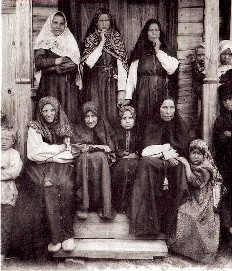
Types of the "coast-dwelling" [pomortsev] dissenters
in the Transvolga region, Karel'ckoi
village. Postcard No 72,
published by M. Dmitriev, Novo-Novgorod, 1900-1904.
These women and children
are
most likely a sub-group of Old Believers as stated, but those in white
look quite different and may be Molokans
who were prevalent in Samara.
|
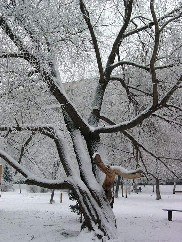
Samara. A tree which possibly remained from
the old Molokan Orchard [Fadeyev's Park, Lenin Avenue].
Photo 2005. |
| Заселение Молоканского сада
продолжалось вплоть до 1915-1916 годов.
Почти каждый двор имел фруктовые деревья, оставшиеся от старого сада.
Преимущественно это были груши. Даже в конце 1950 — начале 1960 годов
эти деревья достигали иногда десятиметровой высоты. Плоды груши
стали
уже небольшими, и жители Молоканского сада называли их дульками. Помню,
что даже в конце 30-х годов в полисаднике дома по улице Дурова 5, росла
старая растрескавшаяся груша, которую спилили лишь перед войной. От
старого сада остались и другие деревья. Так, в начале улицы
Дурова,
возле дома священника, рос огромный "столетний" дуб. |
Residents continued to move into
the
Molokan Orchard up to 1915-1916. Almost
each backyard had fruit trees which remained from the old orchard.
Predominantly these were pear trees. Even at the end of the
1950s to the beginning
of the 1960s, these trees sometimes reached ten-meters in height [33
feet]. The
pear fruit became really small, and the residents of the Molokan
Orchard
called them dul'kami [small
pears]. I
remember that even at the end of the 1930s in the frontyard
of
the house at #5 Durova Street, there was an old
cracked pear tree which was cut down just before the war [WWII]. There
were other trees that remained from the
old orchard. For example, at the beginning of Durova Street,
near the Priest's house, grew an enormous "centenary" oak [100 years
old]. |
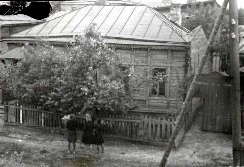
Molokan
Orchard. Apartment house at 5 Durova Street. [I stood
in the yard of the house at 1 Lenin Avenue]. My house. Photo 1951. |
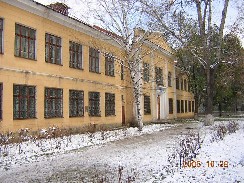
Samara.
Bol'nichnaia Street. School No. 30. Photo 2005. |
| За рядами домов по улице Дурова
почти в каждом подворье имелись
огороды. За огородами, по четной стороне домов, проходила улица
Рыковская (Осипенко), а по нечетной стороне — остатки старого сада и
пустыри. Сама улица была мощена булыжником. Все дома были
преимущественно деревянной постройки. Несколько домов было двухэтажных.
|
Behind the rows of houses along
Durova Street there were vegetable-gardens in nearly every backyard.
Behind the vegetable-gardens, along
the
even-number houses, there was Rykovskaia Street (now: Osipenko), and
along
the odd-numbered houses were remainders of the old orchard and vacant
land. The street itself
was paved with cobblestone. All houses were predominantly wooden
buildings. Several houses were two-story. |
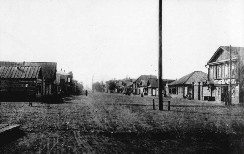
Samara. Solov'inaia Street from Mel'hichnoi
Street perpendicular to Polevoi Street. [Michurin's Street
from Klinichka St. to Polevoi St, ]. Photo ~1913.
|
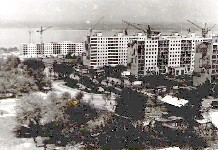
Kuibyshev. Constuction of a new city block
at the intersection of Novo-sadovo and Osipenko streets.
[Aerial photo of new apartments, old buildings in front and Volga River
in back.] Photo
~ 1970.
|
Улица Красинская также была
мощена булыжником. От улицы Дурова по ней можно было пройти до школы №
30. Школа стоит до сих пор. Перед школой № 30 располагалось двухэтажное
деревянное строение, в котором размещалась школа рабочей молодежи. На
улице Красинской имелась водоколонка, которой пользовались жители обеих
улиц. Магазинов на этих улицах не было. От школы № 30, если идти к
улице Мичурина, можно было выйти к известному в городе книжному
магазину. Магазин располагался в двухэтажном деревянном доме,
покрашенном зеленой краской. На первом этаже располагался
непосредственно магазин, а на втором — квартиры для жилья.
|
Krasinskaya Street was also
paved in cobblestone. One could walk to School № 30 from Durova Street.
The School is still there. In front of School №
30 was a two-story wooden building which was a school for young working
people [trade or vocational school]. A
water-tower was on Krasinkoi Street which residents of both streets
used. There were
no stores on these streets. From School № 30, if you walked to
Michurin's
street, you would arrive at a book store known throughout the
city.
The store was located in a two-story wooden building, painted green.
The bookstore occupied first floor, and apartments were on the
second floor.
|
| Если выходить к улице Мичурина
по улице Дуровой, то можно было выйти к
бензозаправочной станции. А далее, через улицу Мичурина к улице Ленской
можно было пройти и к базару Цыганка. Улица Ленская соединяла базар
Цыганка и трамвайное депо, расположенное на улице Полевой. |
If you exit Michurin's Street
to Durova Street, then you would arrive at a gas station. But if you
walk further, across
Michurin's Street to Lenskoi Street, you would arrive at the Gypsy
market [outdoor farmers' market]. Lenskoi Street connected the Gypsy
market and tram
[electric street-car]
depot, located on Polevoi Street.
|
| Летним вечером на улице Дурова
часто вывешивали на фонарном столбе
киноэкран. И киномеханик демонстрировал к удовольствию жителей
Молоканского сада кино. |
During summer evenings on Durova
Street they would often hang a movie
screen from a lamp post. And a movie technician would show a movie for
the enjoyment of the residents of the Molokan Orchard. |
| Мелёхина
(Бичурова) Н. Г. |
by Melekhina
(Bichurova) N. G. |
| В настоящее время Молоканского в
Самаре не существует. Большую часть его территории занимает II
Мичуринский микрорайон. |
Now the Molokan Orchard no
longer
exists in Samara. Most of it's land is now occupied by the II
Michurinski neighborhood [micro-raion]. |

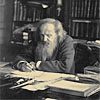 Samara, 1870-1970
Samara, 1870-1970







